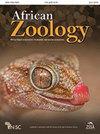南大西洋同域掠食性鱼类和鱿鱼金属成分和浓度的差异
IF 0.5
4区 生物学
Q4 ZOOLOGY
引用次数: 4
摘要
金属自然存在于环境和生物体中。由于人为和自然来源的积累,营养水平较高的生物体可能含有高浓度的金属,这可能使它们更容易受到有害影响,并将其传递给消费者。采用电感耦合等离子体质谱法对2017年2月和2019年2月在南非南大西洋海域采集的鳕鱼(Merluccius capensis)、金唇鱼(Genypterus capensis)、僧鱼(Lophius vomerinus)和长尾鱼(Loligo reynaudii)中30种金属的浓度进行了定量分析。底栖鱼的金属含量和组成与三种底栖捕食者(鳕鱼、绿鳉和安康鱼)有显著差异。底栖鱼金属浓度和相对模式组成(指纹图谱)相似。由于样本是在80公里半径范围内收集的,因此差异可能是由饮食、栖息地(深度)以及头足类动物和鱼类对金属生理调节的差异等因素综合造成的,而不是由地点造成的。根据南非估计的每日摄入量、总危害商和欧盟对汞、镉和铅的限制,这四种来自南大西洋的重要经济物种对人类食用是安全的。应该研究浮游生物、食草海洋物种和大型食肉动物,如鲨鱼和海豚,以进一步了解金属作为监测未来可能的污染和气候变化、营养转移、毒性效应和人类消费者安全的影响的基线。本文章由计算机程序翻译,如有差异,请以英文原文为准。
Differences in Metal Compositions and Concentrations of Sympatric Predatory Fish and Squid from the South Atlantic Ocean§
Metals occur naturally in the environment and in organisms. Organisms at higher trophic levels may contain metals at elevated concentrations, as a result of accumulation from anthropogenic and natural sources, potentially making them more susceptible to detrimental effects, as well as passing them on to consumers. The concentrations of thirty metals were quantified in hake (Merluccius capensis), kingklip (Genypterus capensis), monkfish (Lophius vomerinus) and chokka (Loligo reynaudii) collected from the South Atlantic Ocean of South Africa in February 2017 and February 2019, using inductively coupled plasma mass spectrometry. Metal concentrations and composition in nektobenthic chokka differed significantly from the three demersal fish predators (hake, kingklip, and monkfish). Demersal fish metal concentrations and relative pattern compositions (fingerprints) were similar. Because the samples were collected within an 80 km radius, the differences are likely as a result of a combination of factors, such as diet, habitat (depth), and differences in the physiological regulation of metals between cephalopods and fish, rather than location. Based on South African estimated daily intake, total hazard quotient and European Union limits for mercury, cadmium and lead, these four economically important species from the South Atlantic Ocean are safe for human consumption. Plankton, herbivorous marine species, and larger predators, such as sharks and dolphins, should be studied to obtain further insight into metals as baseline for monitoring possible future pollution and effects from climate change, trophic transfer, toxic effects, and human consumer safety.
求助全文
通过发布文献求助,成功后即可免费获取论文全文。
去求助
来源期刊

African Zoology
生物-动物学
CiteScore
2.60
自引率
9.10%
发文量
18
审稿时长
>12 weeks
期刊介绍:
African Zoology , a peer-reviewed research journal, publishes original scientific contributions and critical reviews that focus principally on African fauna in terrestrial, freshwater, and marine ecosystems. Research from other regions that advances practical and theoretical aspects of zoology will be considered. Rigorous question-driven research in all aspects of zoology will take precedence over descriptive research. The Journal publishes full-length papers, critical reviews, short communications, letters to the editors as well as book reviews. Contributions based on purely observational, descriptive or anecdotal data will not be considered.
The Journal is produced by NISC in association with the Zoological Society of South Africa (ZSSA). Acceptance of papers is the responsibility of the Editors-in-Chief in consultation with the Editors and members of the Editorial Advisory Board. All views expressed are those of the author and not necessarily those of the Editors or the Department.
 求助内容:
求助内容: 应助结果提醒方式:
应助结果提醒方式:


